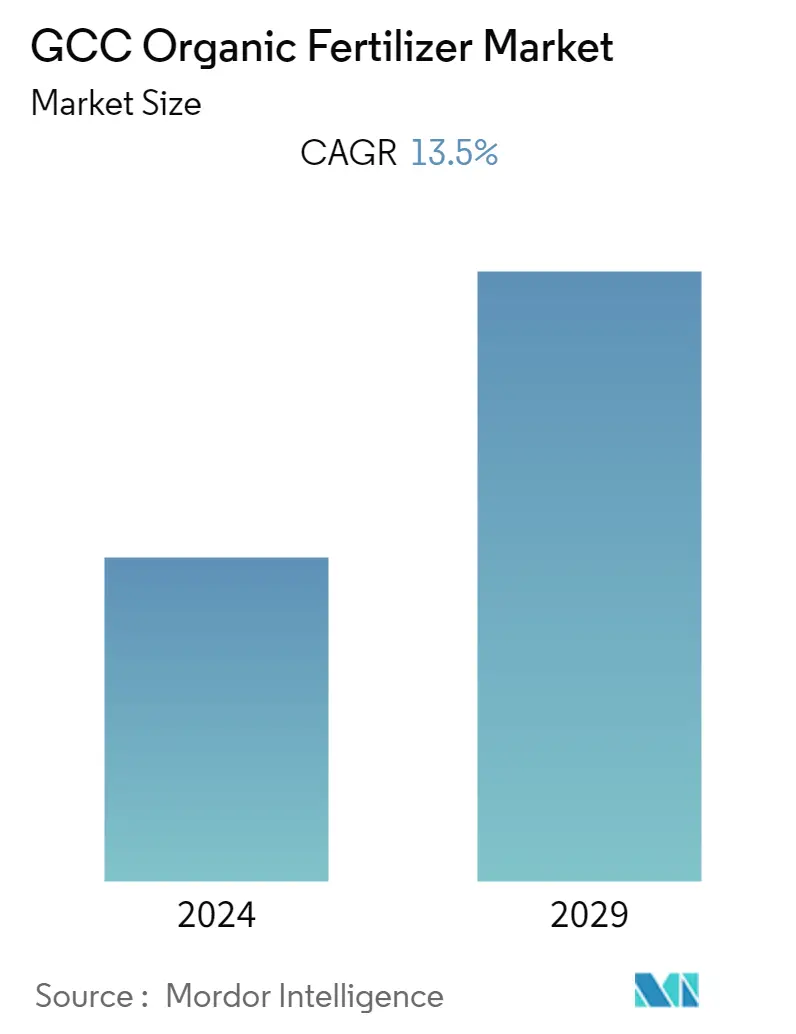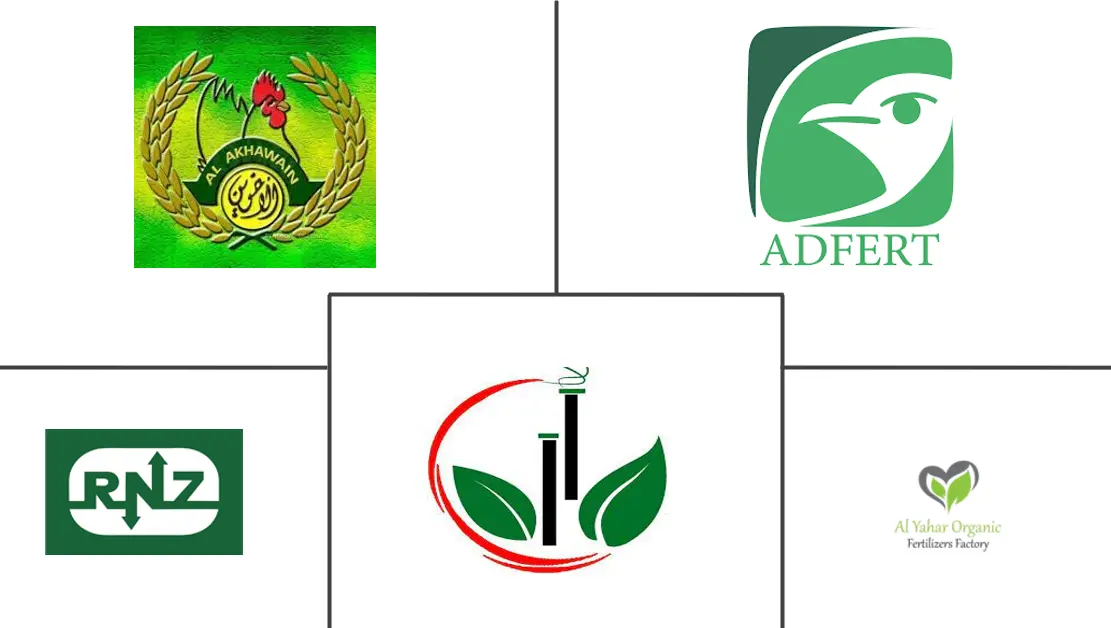Market Size of GCC Organic Fertilizer Industry

| Study Period | 2019 - 2029 |
| Base Year For Estimation | 2023 |
| Forecast Data Period | 2024 - 2029 |
| Historical Data Period | 2019 - 2022 |
| CAGR | 13.50 % |
| Market Concentration | High |
Major Players
*Disclaimer: Major Players sorted in no particular order |
GCC Organic Fertilizer Market Analysis
The GCC organic fertilizer market is projected to register a CAGR of 13.5% during the forecast period.
- The increasing focus on organic farming practices and the high availability of raw materials for fertilizer production are the two major factors driving the GCC organic fertilizer market. Following the pandemic, there is a greater awareness of healthy food among the region's consumers, resulting in an increase in demand for organic food.This, in turn, increased organic food sales in the major countries. According to the Dubai Chamber of Commerce and Industry, organic food sales reached USD 34 million in the United Arab Emirates in 2020, 8.7% higher than in 2019.
- Along with this, the availability of raw materials and increasing interest in organic farming practices are boosting the organic fertilizer sector. Additionally, the ongoing state-led programs for the development of organic fertilizers implemented by the central and state governments and the huge expansions of harvest areas for organic agriculture are also boosting the market studied. For instance, according to the FiBL statistics, the organic agriculture land in the UAE was 5,419 hectares in 2020, which showed an increase from 4,642 hectares in 2019.
Moreover, the increased investments in organic farming startups in the major countries are also supporting the increased use of organic fertilizers in the GCC region. For instance, in June 2021, Red Sea Farms, a Saudi Arabia-based organic farming start-up, received funding of USD 10 million from a group of Saudi and UAE investors. Such investments in the organic farming ecosystem directly impact the growth of organic fertilizers in the region. Therefore, the increase in health consciousness coupled with the increased area under farming are the factors driving the growth of the organic fertilizer markets in the GCC countries.
GCC Organic Fertilizer Industry Segmentation
Organic fertilizers are primarily derived from animal- and plant-based residues and mineral ores. They are developed from beneficial microorganisms. Naturally occurring organic fertilizers include animal wastes from meat processing, peat, manure, slurry, and guano. The GCC Organic Fertilizer Market is Segmented by Product Group (Organic Residues and Bio-fertilizer), Application (Grains and Cereals, Pulses and Oilseeds, Fruits and Vegetables, Commercial Crops, and Turf and Ornamental), and Geography (Saudi Arabia, Qatar, Oman, United Arab of Emirates, Bahrain, and Rest of GCC). The report offers market size and forecast by value (USD million) for the above segments.
| Product Group | |||||||
| |||||||
|
| Application | |
| Grains and Cereals | |
| Pulses and Oilseeds | |
| Fruits and Vegetables | |
| Commercial Crops | |
| Turf and Ornamentals |
| Geography | |
| Saudi Arabia | |
| United Arab Emirates | |
| Qatar | |
| Oman | |
| Bahrain | |
| Rest of GCC |
GCC Organic Fertilizer Market Size Summary
The GCC organic fertilizer market is experiencing significant growth, driven by an increasing focus on organic farming practices and the abundant availability of raw materials for fertilizer production. The heightened consumer awareness of healthy food options post-pandemic has led to a surge in demand for organic food, thereby boosting organic food sales across major GCC countries. This trend is further supported by state-led initiatives and programs aimed at developing organic fertilizers and expanding organic agriculture areas. The region's investment in organic farming startups also plays a crucial role in enhancing the adoption of organic fertilizers, as seen with substantial funding received by companies like Red Sea Farms in Saudi Arabia. The growing health consciousness and the expansion of organic farmland are key factors propelling the market's growth.
Saudi Arabia stands out as the largest market within the GCC, with a robust organic sector supported by government initiatives to promote eco-friendly farming systems. The Saudi government's investment in agriculture innovation has significantly increased the number of organic farms, aligning with the country's strategy to boost the organic market and safeguard natural resources. The rising demand for organic products, driven by urbanization and higher disposable incomes, is further fueling the need for organic fertilizers. The concentration of organic product consumption in major urban areas like Riyadh and Jeddah underscores the demand for organic production, prompting government efforts to adopt sustainable agricultural practices. The GCC organic fertilizer market is dominated by a few key players, who are focusing on sustainable product innovation and expanding their production and distribution capabilities to meet the growing demand.
GCC Organic Fertilizer Market Size - Table of Contents
-
1. MARKET DYNAMICS
-
1.1 Market Overview
-
1.2 Market Drivers
-
1.3 Market Restraints
-
1.4 Porter's Five Forces Analysis
-
1.4.1 Bargaining Power of Suppliers
-
1.4.2 Bargaining Power of Buyers/Consumers
-
1.4.3 Threat of New Entrants
-
1.4.4 Threat of Substitute Products
-
1.4.5 Intensity of Competitive Rivalry
-
-
-
2. MARKET SEGMENTATION
-
2.1 Product Group
-
2.1.1 Organic Residues
-
2.1.1.1 Farmyard Manure
-
2.1.1.2 Crop Residues
-
2.1.1.3 Green Manure
-
2.1.1.4 Other Organic Residues
-
-
2.1.2 Bio-fertilizers
-
2.1.2.1 Rhizobium
-
2.1.2.2 Azotobacter
-
2.1.2.3 Azospirillum
-
2.1.2.4 Mycorrhizae
-
2.1.2.5 Other Bio-fertilizers
-
-
-
2.2 Application
-
2.2.1 Grains and Cereals
-
2.2.2 Pulses and Oilseeds
-
2.2.3 Fruits and Vegetables
-
2.2.4 Commercial Crops
-
2.2.5 Turf and Ornamentals
-
-
2.3 Geography
-
2.3.1 Saudi Arabia
-
2.3.2 United Arab Emirates
-
2.3.3 Qatar
-
2.3.4 Oman
-
2.3.5 Bahrain
-
2.3.6 Rest of GCC
-
-
GCC Organic Fertilizer Market Size FAQs
What is the current GCC Organic Fertilizer Market size?
The GCC Organic Fertilizer Market is projected to register a CAGR of 13.5% during the forecast period (2024-2029)
Who are the key players in GCC Organic Fertilizer Market?
Al-Akhawain, RNZ Group, Abu Dhabi Fertilizer Industries Co. WLL, Al Madeena Organic Fertilizers and Al Yahar Fertilizers are the major companies operating in the GCC Organic Fertilizer Market.

